
distance, upstream of the confluence.
Figure 14 illustrates this jamming
mechanism for ice merging at the con-
fluence of the Iowa and Cedar Rivers
near Columbus Junction, Iowa. Where-
as ice continued moving through the
Cedar River into the confluence, ice
jammed in the Iowa River immedi-
ately upstream of the confluence.
The following four factors signifi-
cantly influence jamming:
1. The relative location of the divid-
ing streamline between the merg-
ing flows (see Fig. 8).
2. The relative magnitude of the
flow-separation zone (see Fig. 8).
3. The proximity to incipient jam-
ming in each inflow channel, C1/
C1max or C2/C2max.
4. The increasing backwater effect
created by ice congestion in the
confluence.
Figure 13. Jamming of merging ice runs.
The first and second factors reflect
the influences of the parameter bc/b3 and bs/b3, which combine the effects of con-
fluence angles (α,θ), the widths of the confluence channels (b1/b2, b2/b3), and the
integral effect of the flow and ice parameters for each channel. The fourth factor is
a feedback outcome of confluence congestion by accumulating ice; it reflects the
interactive nature of jamming and flow. As a jam forms and begins retarding flow,
flow depth increases at and upstream of the jam site, and flow velocity decreases
commensurately. A decrease in flow velocity may hasten jam formation, because
it reduces flow drag on the jam as it forms.
Figure 14. Ice jamming at the confluence of the Iowa and Cedar Rivers.
27
Back to contents page



 Previous Page
Previous Page
